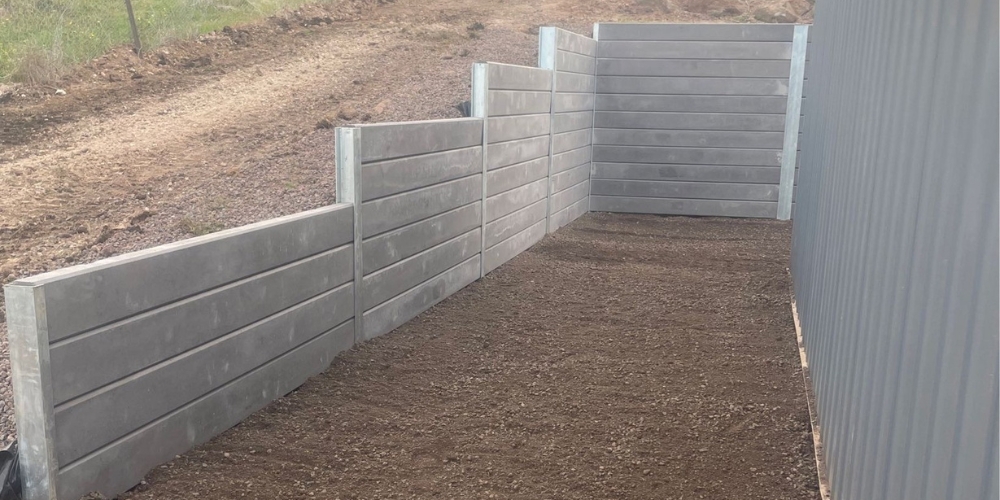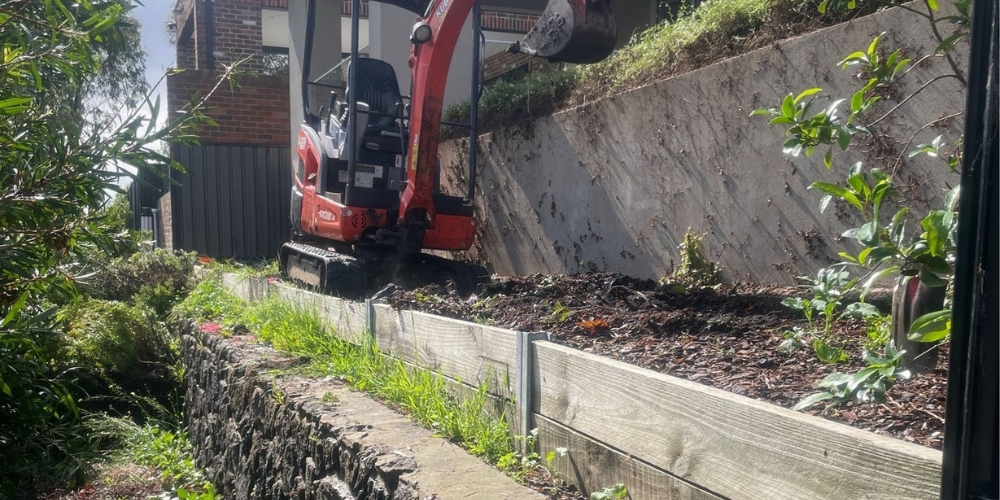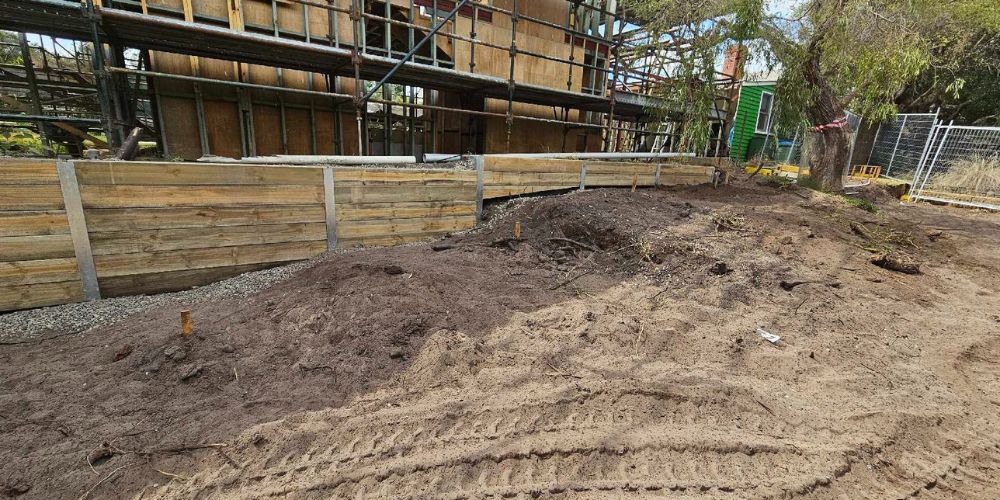Who Pays for a Retaining Wall on a Boundary?
Reading time: 8min 5 sec

Alex
So, you’re considering building a retaining wall on your property boundary. It’s a smart move, but let’s talk about the dollars and cents of it all.
Here’s the deal: Building a retaining wall can be a wallet-squeezer. Before digging into your savings, do you know you can legally share expenses with your neighbour?
Typically, when it comes to divvying up the bill for a retaining wall on a boundary, it’s a shared effort between you and your neighbour. If the wall benefits both properties by holding back soil or levelling the uneven ground, it’s fair for both parties to chip in.

Factors that Determine the Need for a Retaining Wall on a Property Boundary
When you decide if your property boundary requires a retaining wall, there are a few important things to consider. These factors may help you determine whether a retaining wall is required to handle specific issues or conditions on your property.
Here are some things that you need to consider:
Erosion and Slope
Controlling slopes and halting soil erosion are two main goals of retaining wall installation. A retaining wall can assist in stabilising the soil and stop land loss if your property has steep topography or suffers from runoff or rainfall-related erosion.
Property Lines
To distinguish and divide neighbouring land parcels, retaining walls are frequently constructed along property borders. Retaining walls may be required to produce a level or terraced surface if your property borders a neighbour and their property is at a different elevation.
Drainage of Water
Think about the way the water flows off your land. Inadequate drainage can result in flooding or water retention, weakening the soil’s stability and accelerating erosion. Retaining walls can be built to control water runoff efficiently or to divert water flow away from your property.
Stability of Structure
Examine your site’s buildings, driveways, and walkways to determine their structural soundness. These constructions may be at risk if the soil is unstable or prone to shifting. Retaining walls can maintain and strengthen soil movement and possible structural damage.
Aesthetics and Landscaping
Landscaped areas or terraced gardens can be created with retaining walls, which can also have aesthetic benefits. Retaining walls can assist in turning steep or uneven terrain into aesthetically pleasing and practical places, whether your goal is to improve the appearance of your property or create useable outdoor spaces.
Regulatory Requirements
Check local building codes and zoning regulations to identify if a retaining wall is required or if there are specific guidelines you need to follow. Depending on your location and the height or location.
Laws and Regulations on Retaining Walls
When it comes to building retaining walls, we explain several laws and regulations that property owners need to be aware of to ensure compliance and safety. Here’s an overview of some key aspects to consider:
Local Government Regulations
In Australia, retaining wall construction is governed by state and territory-specific building codes and rules. These rules may change based on the retaining wall’s location, height, and material employed. Before starting any building, property owners should become familiar with the local regulations.
Development Approval
Building permits or development clearance from the local government are frequently needed before retaining wall construction can begin. The approval process usually entails submitting comprehensive drawings and specifications to guarantee that the retaining wall complies with building laws and regulations. If the required approvals are not obtained, fines or legal repercussions may occur.
Engineering Standards
To maintain structural integrity and safety, retaining walls must be designed and built according to engineering requirements. This could include things like the kind of soil, drainage issues, and the placement and height of the retaining wall. It could be necessary for you to hire a structural designer or skilled engineer to evaluate the site and create suitable retaining wall plans.
Property Boundaries
Establishing ownership and accountability with other property owners is important before constructing a retaining wall on a boundary. Formal agreements or easements might be required to specify each party’s rights and responsibilities about the retaining wall’s building, upkeep, and cost-sharing.
Environmental Considerations
The surrounding environment, including vegetation, water drainage, and soil stability, can be impacted by retaining wall construction. Real estate owners should be aware of any environmental laws or regulations relevant to their location, such as habitat preservation, erosion control techniques, or the preservation of native plants.
Safety Standards
Building retaining walls is necessary to guarantee the security of both tenants and onlookers. This involves considering acceptable distances from buildings and property boundaries, sufficient anchoring to handle soil pressure, and good drainage to minimise water buildup. Adherence to safety regulations is crucial to mitigate the likelihood of mishaps or structural malfunctions.

Who Pays For a Retaining Wall?
If you’re asking me, the responsibility for paying for retaining wall construction typically falls on both property owners whose land is affected by the wall. It’s often a shared effort, especially if the wall benefits both properties by preventing erosion, managing water runoff, or creating level ground.
However, there are instances where the responsibility might lean more towards one party.
Shared Benefit
It’s usually reasonable for both property owners to split the expense of a retaining wall if it helps both properties by controlling water drainage, avoiding soil erosion, or establishing level ground. Usually, this shared duty entails haggling over costs and coming to an equitable cost-sharing arrangement.
Property Improvement
The property owner who starts the construction may be responsible for the entire expense if the retaining wall improves one property’s appearance, functionality, or structural stability. However, this can change based on regional legislation and existing agreements.
Legal Obligations
In certain instances, municipal ordinances or property laws may determine who is in charge of building or maintaining a retaining wall. Real estate owners should check applicable laws or agreements and speak with local authorities.
Neighbourhood Cooperation
Regardless of legal requirements, fostering open communication and cooperation with neighbours is crucial when retaining walls. Discussing the project, sharing concerns, and reaching mutually beneficial agreements can prevent disputes and ensure a smooth process.
Insurance Coverage
Homeowners’ insurance policies may cover retaining walls damaged by covered perils such as storms, landslides, or accidents. However, coverage may vary depending on policy terms and the cause of damage. Property owners should review their insurance policies and consult their providers to understand coverage options.

How To Negotiate With Your Neighbor
We all want to maintain harmonious relationships with our neighbours and negotiating shared responsibilities like retaining a wall can be delicate.
Here are some tips that work (because this is how we do it) to help you navigate the negotiation process smoothly:
Initiate the Conversation
Commence by striking up a cordial and non-aggressive discussion with your neighbour. Select a suitable moment and location where everyone is easily and willing to talk. You could speak with them face-to-face, over the phone, or even through an email or a nice note. Establishing a constructive rapport right away and genuinely expressing your want to work together to achieve a workable solution is crucial.
Express Your Concerns
Express your concerns about the matter at hand clearly and concisely. Regarding the retaining wall, noise, property lines, or anything else, be truthful and considerate while sharing your viewpoint. Instead of blaming or pointing fingers, use “I” phrases to explain how the situation impacts you. You’re being courteous and collected when you explain yourself.
Listen Actively
Give your neighbour a chance to share their ideas, worries, and points of view on the subject. You actively listen by focusing entirely on them, keeping eye contact, and avoiding interruptions. Even if you don’t share their opinion, be sympathetic and empathetic. You may foster a more accommodating bargaining environment by showing appreciation for their opinions and willingness to hear them out.
Find Common Ground
Seek out your neighbour’s areas of agreement and common interests. Stress shared objectives like upholding a quiet neighbourhood, protecting property values, or encouraging wholesome relationships. You may establish rapport and provide the groundwork for a cooperative approach to problem-solving by concentrating on shared interests.
Explore Options
Come up with a list of possible fixes with your neighbour. Be imaginative and receptive when investigating various strategies for the current problem. Think about other approaches or concessions that satisfy the requirements and objectives of both sides. Invite your neighbour to share their thoughts and recommendations, and listen to what they say. The objective is to cooperate to arrive at a solution that both parties can agree upon.
Reach a Mutually Beneficial Agreement
Strive to come to a compromise that benefits both sides and considers their concerns. Find solutions that balance your different priorities and areas of interest by being willing to make concessions. Give a clear explanation of the terms of the agreement, including any particular duties or obligations on the side of each party. Document the agreement in writing to ensure clarity and avoid misunderstandings in the future. By reaching a positive resolution through negotiation, you can strengthen your relationship with your neighbour and create a more harmonious living environment for everyone involved.
Can Retaining Walls Be Insured?
Yes, retaining walls can often be insured. Still, the coverage can vary depending on the type of insurance policy you have and the circumstances of the damage.
Homeowners’ insurance typically covers retaining walls as part of the property’s structure, covering damage from storms, landslides, and accidents. However, coverage limits and exclusions exist, and flood damage may require separate insurance. Policy endorsements can also enhance retaining wall coverage for specific risks.
Before assuming that your retaining wall is covered by insurance, you must review your homeowner’s insurance policy carefully and consult with your insurance provider to understand the extent of your coverage. If you have concerns about retaining wall coverage or need additional protection, consider discussing your options with your insurance agent to ensure adequate insurance.
Frequently Asked Questions
You should look into other choices, including getting legal counsel, mediation, or dispute resolution services if your neighbour didn’t pay for the retaining wall, even though both of you will profit from it. Handling the matter patiently is necessary to solve for all sides.
Investing in a retaining wall on a property boundary can offer several long-term benefits, including improved property aesthetics, increased usable land area, enhanced property value, and reduced risk of erosion or soil instability. Additionally, addressing drainage issues and stabilising slopes can help protect your property and neighbouring properties from potential damage and erosion over time.
If the retaining wall was built before you purchased your property, you may still be responsible for its maintenance and costs, depending on local laws and agreements. Reviewing your property documents, such as the deed or title report, is essential to understand your responsibilities regarding the retaining wall. Additionally, consulting with legal or real estate experts can clarify your obligations.
Conclusion
Always remember that retaining walls on property boundaries installation requires cooperation and open communication. Even though figuring out who pays for what might occasionally feel like a maze, if you approach the problem patiently and understandingly, you can find a solution that works for everyone.
Maintaining open lines of communication and looking for common ground is essential, regardless of who started the project—you or your neighbour. It is possible to prevent misunderstandings and forge closer bonds with your neighbours by discussing issues, considering choices, and identifying points of agreement.
If you disagree, don’t hesitate to seek assistance from legal professionals or mediators who can help facilitate productive discussions and find fair resolutions.
Investing time and effort into resolving retaining wall issues can lead to long-term benefits, such as improved property value, enhanced stability, and, most importantly, maintaining harmony in your neighbourhood. So, roll up your sleeves, engage with your neighbours, and work together towards a solution that works for everyone. Your property—and your relationships—will thank you for it.

Alex
More To Explore

Boulder vs. Rock Retaining Walls: Which One Should You Choose?
Share on facebook Facebook Share on twitter Twitter Share on linkedin LinkedIn Share on whatsapp WhatsApp Table of Contents If you’ve been thinking about building a retaining wall, one of the biggest questions you might face is whether to go with a boulder wall or a rock wall. Each option has its strengths, and choosing

How Long Does a Typical Excavation Project Take?
Share on facebook Facebook Share on twitter Twitter Share on linkedin LinkedIn Share on whatsapp WhatsApp Table of Contents When starting a construction or landscaping project, one of the first questions people ask is, “How long will it take?” Excavation is a critical first step in many projects, setting the foundation (literally) for everything that

What is an Emergency Excavation?
Share on facebook Facebook Share on twitter Twitter Share on linkedin LinkedIn Share on whatsapp WhatsApp Table of Contents When you think about excavation, you probably imagine a well-planned project where the site is prepared, utilities are marked, and every detail is carefully mapped out. But not all excavations have the luxury of time. Sometimes,
